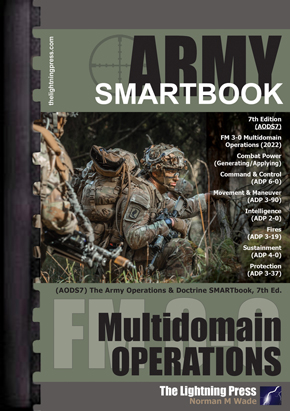Multidomain operations are the combined arms employment of joint and Army capabilities to create and exploit relative advantages that achieve objectives, defeat enemy forces, and consolidate gains on behalf of joint force commanders.
Employing Army and joint capabilities makes use of all available combat power from each domain to accomplish missions at least cost. Multidomain operations are the Army’s contribution to joint campaigns, spanning the competition continuum.

Army forces conduct operations in support of joint campaigns which for the most part occur as part of a larger coalition operation. Leaders must understand the interdependencies between their own assigned forces and the forces or capabilities provided by others to generate the complementary and reinforcing effects of combined arms approaches. Army forces employ joint and other unified action partner capabilities to the degree they are available. However, because peer threats can contest the force in all domains, Army forces must be prepared to conduct operations when some or all joint capabilities are unavailable to support mission accomplishment.
All operations are multidomain operations. Army forces employ organic capabilities in multiple domains, and they continuously benefit from air and maritime strategic transportation and space and cyberspace capabilities that they do not control, including global positioning, satellite communications, and intelligence, surveillance, and reconnaissance (ISR). Lower echelons may not always notice the opportunities created by higher echelons or other forces that operate primarily in other domains; however, leaders must understand how the absence of those opportunities affects their concepts of operations, decision making, and risk assessment.
During operations, small advantages can have significant impacts on the outcome of the mission, particularly when they accrue over time. Creating and exploiting relative advantages are therefore necessary for all operations, and they become even more critical when opposing sides are evenly matched. A relative advantage is a location or condition, in any domain, relative to an adversary or enemy that provides an opportunity to progress towards or achieve an objective. Commanders seek and create relative advantages to exploit through action, and they continually assess the situation to identify ways to expand opportunities.
Army leaders are accustomed to creating and exploiting relative advantages through the combined-arms approach that traditionally focuses on capabilities from the land, air, and maritime domains. The proliferation of space and cyberspace capabilities further requires leaders who understand the advantages those capabilities create in their operational environment. The ability to integrate and synchronize space and cyberspace capabilities at the most effective tactical echelon expands options for creating advantages to exploit.
Multidomain operations fracture the coherence of threat operational approaches by destroying, dislocating, isolating, and disintegrating their interdependent systems and formations, and exploiting the opportunities these disruptions provide to defeat enemy forces in detail. Army forces therefore require timely, accurate, relevant, and predictive intelligence to understand threat characteristics, capabilities, objectives, and courses of action. Intelligence initially drives what combinations of defeat mechanisms commanders pursue as they employ the capabilities of their forces in space and time against enemy forces. Army forces combine maneuver and targeting methods to defeat enemy formations and systems. Army forces employ maneuver to close with and destroy enemy formations in close operations. Targeting generally sets priorities for information collection, fires, and other key capabilities to disintegrate enemy networks and systems. Leaders execute the targeting process to create advantages that enable freedom of maneuver and exploit the positional advantages created by maneuver.
 This article is an extract from "AODS7: The Army Operations & Doctrine SMARTbook, 7th Ed. (Multidomain Operations)" by The Lightning Press. Download a free PDF sample and learn more at: AODS7: The Army Operations & Doctrine SMARTbook, 7th Ed. (Multidomain Operations).
This article is an extract from "AODS7: The Army Operations & Doctrine SMARTbook, 7th Ed. (Multidomain Operations)" by The Lightning Press. Download a free PDF sample and learn more at: AODS7: The Army Operations & Doctrine SMARTbook, 7th Ed. (Multidomain Operations).
Browse additional military doctrine articles in our SMARTnews Blog & Resource Center.
About The Lightning Press SMARTbooks. Recognized as a “whole of government” doctrinal reference standard by military, national security and government professionals around the world, SMARTbooks comprise a comprehensive professional library. SMARTbooks can be used as quick reference guides during operations, as study guides at education and professional development courses, and as lesson plans and checklists in support of training. Browse our collection of Military Reference SMARTbooks to learn more.













































